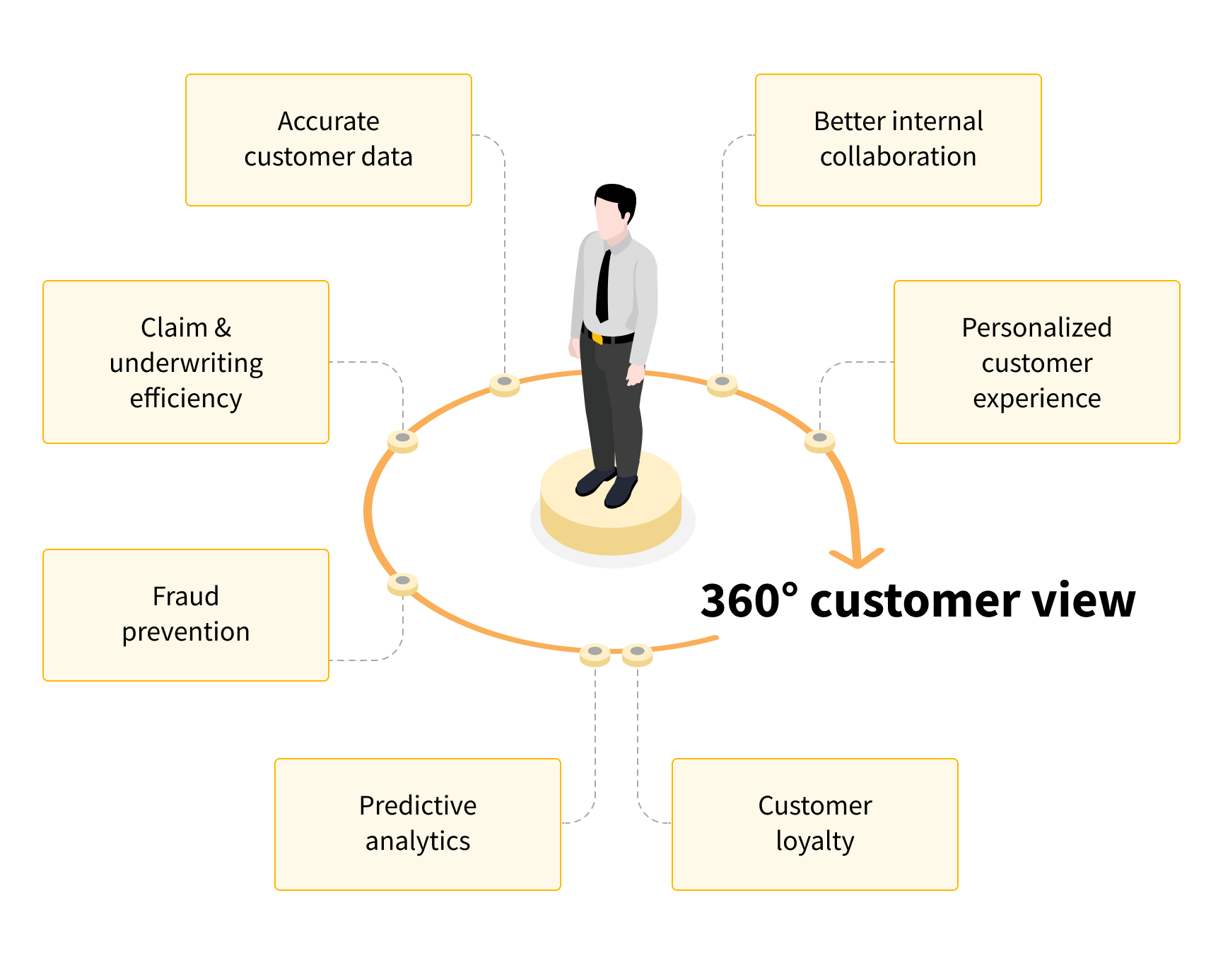
Insurance data 360: Sync your business data ecosystem, eliminate silos and see ultimate efficiency at scale
Data is the lifeblood of insurance. Having accurate information regarding customers' demographics, medical history, and socioeconomic status allows insurance companies to understand their clients well enough to offer protection tailored to their specific needs.
However, times are changing. Insurance customers no longer behave the same way they used to. Today, they are not only looking to get the best product but also expect a personal touch and superior experience. In fact, according to a recent PwC report, 73% of consumers say that positive customer experience is one of the top 3 factors shaping their purchasing decision, the other two being price and product quality.
In order to keep up with customer expectations, insurance companies have to reverse their habitual mode of doing business and adopt a more customer-centric approach. This requires a complete, holistic view of their relationship with a customer, which goes beyond the client's basic contact information and policy details.
Forward-thinking insurers focus on tracking all interactions a policyholder has with their brand across numerous touchpoints – from product browsing history and contacting customer service, to social media activity and responses to marketing campaigns. The combination of data from all these channels creates a unique record for each client.

Having a 360-degree view of policyholders helps insurance companies fine-tune their risk profiles and offer more personalized marketing, sales, and service engagements. With data streaming into insurance companies from multiple sources, and recorded cohesively for each customer, makes it easier for insurance agents to understand the evolving needs of their customers and identify the gaps in insurance to provide clients with custom-made policies. Furthermore, a 360-degree view not only helps to bolster lucrative customer relationships but also leads to improved, more informed underwriting and claims handling processes.
Unlocking the value of customer data with an advanced data management system
Building a customer 360-degree view is not possible without a robust analytics platform that helps to manage data assets, increase data quality and accessibility, and consistently turn unstructured business information into actionable insights. To unlock the value of data and enable its effective use, the solution has to be:
- Holistic. The data management system must be able to tie together information from all the data streams within the enterprise – CRM, emails, social media, transactional systems, IoT, mobile app and website. It should also incorporate customer feedback collected from a variety of touchpoints, including online purchases, IVR, support portal, and live communication with insurance agents.
- Scalable. The solution has to be flexible enough to adapt to an ever-increasing volume and variety of incoming data. This is a fundamental feature of successful digitalization of data pipelines. With an advanced analytics platform, a customer 360-view is made possible by integrating multiple external and internal datasets and automation capabilities, offering a way to extract, clean, and combine data across systems.
- Compliant with security frameworks. The safety of proprietary and customer information is a mandatory requirement in the insurance business. Therefore, the data management system has to adhere to the security regulations introduced by law and protect the confidentiality, integrity, and availability of sensitive information.
- Future-proof. For a long time data has been seen as a by-product of the insurance business but today more and more companies realize they need to place it at the heart of their operations to stay on top of the game. The longer the transformation process takes, the more info may be out of sync, turning a prosperous data lake into a useless data swamp.
According to a recent report on data-driven transformation in the insurance industry, the majority of insurance professionals (81%) feel that modernization of data management platforms should remain high on the agenda across insurance companies. At the same time, 55% of agents see the complexity of their existing systems as a major barrier to achieving a 360-degree customer view.
Legacy systems are hard to migrate away from, slow to change, and expensive to maintain. However, application modernization enables organizations to gradually break these monolith structures and shift to microservices architecture without disrupting operations.
Additionally, insurance companies can apply advanced artificial intelligence and machine learning techniques to develop new capabilities and add value to their overall proposition. By adding cloud technology to the mix, insurers can obtain improved expense management, increased reliability, advanced analytics and the ability to scale data storage.
Benefits of 360-degree customer views in insurance ecosystems
A 360-degree customer view encompasses every part of the customer journey. Having a single customer record enables insurance carriers to access customers’ account information quickly, understand their priorities and preferences, anticipate their future needs, provide the right products, up-sell and cross-sell, prevent churn and accelerate claims processing. Such powerful insights take marketing and customer service to the next level which in turn helps to grow the company’s insurance portfolio.

But those are not the only advantages of the golden record. Let’s dive deeper into the benefits of a 360-degree customer view and how to make it work for your goals.
Harmonizing customer data across the insurance enterprise
Traditionally, insurance companies have been product-oriented, offering different types of coverage for life, commercial, property and casualty (P&C) protection. Each of these business areas runs as a separate unit leading to huge troves of data being accumulated in disconnected systems. Under such circumstances, businesses fail to identify a customer across multiple relationships and trace their previous interactions with the company representative. Without a complete picture, insurers often didn't have enough information to make a meaningful impact on service delivery.
A 360-degree customer view offers a single source of truth for better customer alignment across the enterprise. It provides centralized access to customer data to agents, customer service representatives, underwriters, and claim analysts, enabling cross-departmental communication and knowledge sharing. Working with consolidated information coming from different silos, they can instantly find relevant records to perform business intelligence analysis and fix any problems for the customer in minutes, rather than days.
Enhancing personalization
Business transformation should be as much about people as about data management systems. According to McKinsey’s report on getting personalization right, 71% of consumers expect companies to deliver personalized interactions, while 76% are eager to switch brands if the provider fails to recognize them as individuals and know their interests.
If you want to make your cooperation with your customers more meaningful you need to demonstrate your investment in the relationship:
- Meet your clients where they are. From web to mobile and in-person interactions, you can engage your customers across multiple channels. With data aggregated on a single platform, you can get access to your client purchase history, and browsing habits, quickly react to their changing behavior patterns and make relevant adjustments to your product offerings, marketing campaign or sales strategy.
- Know your customers. When asked to define personalization, three-quarters of policyholders characterize it as a positive experience of being made to feel special. You can instill that feeling in your customers by giving them relevant product/service recommendations, offering targeted promotions or tailoring your messaging to their needs.
- Keep in touch. Thorough communication with your clients is equally important at every phase of their customer journey – from acquisition to post-purchase servicing. You shouldn’t neglect the value of the human touch, which sometimes means you will have to try to extend your servicing beyond mere insurance. For example, understanding consumers’ life events can reveal hidden insights unknown to your organization. You can then leverage this information and use customer intelligence techniques to identify missed opportunities for cross-selling and up-selling.
Detecting and preventing fraud
The amount, variety and complexity of data streaming into insurance organizations has grown enormously over the past several years. With companies increasingly becoming more data-driven, the price of errors caused by bad data is too high. To avoid disastrous consequences and improve the accuracy of insights, many insurers started to implement AI-powered data quality monitoring and management solutions.
These tools help detect, prevent, and auto-correct data defects eliminating policy duplication, incorrect customer identification, or multiple insurance claims for the same property. When combined with stream processing, such machine learning anomaly detection algorithms can automatically react to misrepresentation and corrupt data, generating real-time business intelligence and reporting. They are also used in claim processing to identify suspicious activity beyond traditional signals and send up red flags about fraudulent submissions.
Summary
Discordance of customer data across the business ecosystem is one of the greatest challenges for many P&C insurance agencies. Traditionally, insurance companies interacted with policyholders in multiple separate business areas, and for this reason information about customers’ requests and complaints resides in siloed databases managed by different units within the organization.
But times are changing, and in order to keep up with rapidly evolving consumer expectations, insurers need to focus their effort on building a powerful 360-degree customer view. By collating data from myriad touchpoints, carriers can create a single unified policyholder record that allows them to track all interactions a customer has with the business and create personalized experiences based on those insights. If you’re interested to learn more about 360-degree customer views for your insurance company, get in touch with us to start a conversation.
